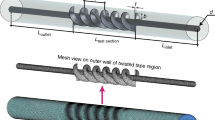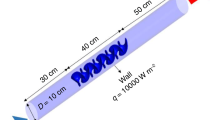Abstract
In this article, influence of inserting new turbulator on resistance and heat transfer behaviors of a pipe has been analyzed. This kind of turbulator can be utilized for retrofit applications. Turbulent nanofluid flow is imposed. Homogenous approach for nanofluid and k–ɛ approach for turbulent modeling were involved. Contours are presented for different inlet velocity and pitch ratio. Results indicated that the lower the pitch ratio, the better is the temperature gradient. Nanofluid transfers more heat with decline of pitch ratio because of lower generation of longitudinal disturbance. As inlet velocity augments and pitch ratio decreases, nanofluid can scour the wall more easily and heat transfer rate is strengthened.








Similar content being viewed by others
Abbreviations
- Pr :
-
Prandtl number
- f :
-
Darcy friction factor
- p :
-
Pressure
- P :
-
Pitch ratio
- Re :
-
Reynolds number
- T :
-
Fluid temperature
- Nu :
-
Nusselt number
- L t :
-
Test section length
- ρ :
-
Density
- ϕ :
-
Concentration of nanoparticles
- μ :
-
Dynamic viscosity of nanofluid
- α :
-
Thermal diffusivity
- s:
-
Solid
- nf:
-
Working fluid
- f:
-
Water
- s:
-
Particles
- p:
-
Smooth
References
Choi SUS. Enhancing thermal conductivity of fluids with nanoparticles. In: Developments and applications of non-Newtonian flows FED, vol 231/MDvol. 66. New York: ASME; 1995. pp. 99–105.
Sadiq MA, Khan AU, Saleem S, Nadeem S. Numerical simulation of oscillatory oblique stagnation point flow of a magneto micropolar nanofluid. RSC Adv. 2019;9:4751–64.
Sheikholeslami M, Jafaryar M, Hedayat M, Shafee A, Li Z, Nguyen TK, Bakouri M. Heat transfer and turbulent simulation of nanomaterial due to compound turbulator including irreversibility analysis. Int J Heat Mass Transf. 2019;137:1290–300.
Mamatha Upadhya S, Raju CSK, Mahesha C, Saleem S. Nonlinear unsteady convection on micro and nanofluids with Cattaneo–Christov heat flux. Results Phys. 2018;9:779–86.
Sheikholeslami M, Haq RU, Shafee A, Li Z, Elaraki YG, Tlili I. Heat transfer simulation of heat storage unit with nanoparticles and fins through a heat exchanger. Int J Heat Mass Transf. 2019;135:470–8.
Shah Z, Islam S, Gul T, Bonyah E, Khan MA. The electrical MHD and hall current impact on micropolar nanofluid flow between rotating parallel plates. Results Phys. 2018;9:1201–14.
Sun Z, Shi J, Wu K, Li X. Gas flow behavior through inorganic nanopores in shale considering confinement effect and moisture content. Ind Eng Chem Res. 2018;57:3430–40.
Kashyap D, Dass AK. Two-phase lattice Boltzmann simulation of natural convection in a Cu–water nanofluid-filled porous cavity: effects of thermal boundary conditions on heat transfer and entropy generation. Adv Powder Technol. 2018;29(11):2707–24.
Wang J, Zhu J, Zhang X, Chen Y. Heat transfer and pressure drop of nanofluids containing carbon nanotubes in laminar flows. Exp Therm Fluid Sci. 2013;44:716–21.
Wen D, Ding Y. Experimental investigation into convective heat transfer of nanofluid at the entrance region under laminar flow conditions. Int J Heat Mass Transf. 2004;47(24):5181–8.
Sheikholeslami M, Jafaryar M, Shafee A, Li Z, Haq RU. Heat transfer of nanoparticles employing innovative turbulator considering entropy generation. Int J Heat Mass Transf. 2019;136:1233–40.
Nadeem S, Ahmed Z, Saleem S. Carbon nanotubes effects in magneto nanofluid flow over a curved stretching surface with variable viscosity. Microsyst Technol. 2018. https://doi.org/10.1007/s00542-018-4232-4.
Animasaun IL, Mahanthesh B, Jagun AO, Bankole TD, Sivaraj R, Shah NA, Saleem S. Significance of Lorentz force and thermoelectric on the flow of 29 nm CuO–water nanofluid on an upper horizontal surface of a paraboloid of revolution. J Heat Transfer. 2019;141(2):022402. https://doi.org/10.1115/1.4041971.
Sheikholeslami M, Keramati H, Shafee A, Li Z, Alawad OA, Tlili I. Nanofluid MHD forced convection heat transfer around the elliptic obstacle inside a permeable lid drive 3D enclosure considering lattice Boltzmann method. Phys A Stat Mech Appl. 2019;523:87–104.
Alkanhal TA, Sheikholeslami M, Arabkoohsar A, Haq RU, Shafee A, Li Z, Tlili I. Simulation of convection heat transfer of magnetic nanoparticles including entropy generation using CVFEM. Int J Heat Mass Transf. 2019;136:146–56.
Sheikholeslami M, Arabkoohsar A, Khan I, Shafee A, Li Z. Impact of Lorentz forces on Fe3O4–water ferrofluid entropy and exergy treatment within a permeable semi annulus. J Clean Prod. 2019;221:885–98.
Roy NC, Rahman T, Hossain MA, Gorla RSR. Boundary-layer characteristics of compressible flow past a heated cylinder with viscous dissipation. J Thermophys Heat Transf. 2019;33(1):10–22. https://doi.org/10.2514/1.t5400.
Hammed H, Haneef M, Shah Z, Islam S, Khan W, Muhammad S. The combined magneto hydrodynamic and electric field effect on an unsteady Maxwell nanofluid flow over a stretching surface under the influence of variable heat and thermal radiation. Appl Sci. 2018;8:160. https://doi.org/10.3390/app8020160.
Rashidi S, Mahian O, Languri EM. Applications of nanofluids in condensing and evaporating systems. J Therm Anal Calorim. 2018;131:2027–39.
Sheikholeslami M, Mahian O. Enhancement of PCM solidification using inorganic nanoparticles and an external magnetic field with application in energy storage systems. J Clean Prod. 2019;215:963–77.
Maleki H, Safaei MR, Alrashed AAA, Kasaeian A. Flow and heat transfer in non-Newtonian nanofluids over porous surfaces. J Therm Anal Calorim. 2018. https://doi.org/10.1007/s10973-018-7277-9.
Sheikholeslami M, Haq RU, Shafee A, Li Z. Heat transfer behavior of nanoparticle enhanced PCM solidification through an enclosure with V shaped fins. Int J Heat Mass Transf. 2019;130:1322–42.
Saleem S, Nadeem S, Rashidi MM, Raju CSK. An optimal analysis of radiated nanomaterial flow with viscous dissipation and heat source. Microsyst Technol. 2019;25:683–9.
Sekrani G, Poncet S, Proulx P. Modeling of convective turbulent heat transfer of water-based Al2O3 nanofluids in an uniformly heated pipe. Chem Eng Sci. 2018;176:205–19.
Yan S, Wang F, Shi Z, Tian R. Heat transfer property of SiO2/water nanofluid flow inside solar collector vacuum tubes. Appl Therm Eng. 2017;118:385–91.
Michael JJ, Iniyan S. Performance of copper oxide/water nanofluid in a flat plate solar water heater under natural and forced circulations. Energy Convers Manag. 2015;95:160–9.
Li Z, Saleem S, Shafee A, Chamkha AJ, Du S. Analytical investigation of nanoparticle migration in a duct considering thermal radiation. J Therm Anal Calorim. 2018. https://doi.org/10.1007/s10973-018-7517-z.
Sheikholeslami M. New computational approach for exergy and entropy analysis of nanofluid under the impact of Lorentz force through a porous media. Comput Methods Appl Mech Eng. 2019;344:319–33.
Sheikholeslami M, Jafaryar M, Shafee A, Li Z. Nanofluid heat transfer and entropy generation through a heat exchanger considering a new turbulator and CuO nanoparticles. J Therm Anal Calorim. 2019;1:1. https://doi.org/10.1007/s10973-018-7866-7.
Sun F, Yao Y, Li X, Li G, Miao Y, Han S, Chen Z. Flow simulation of the mixture system of supercritical CO2 & superheated steam in toe-point injection horizontal wellbores. J Pet Sci Eng. 2018;163:199–210.
Rokni HB, Gupta A, Moore JD, McHugh MA, Bamgbaded BA, Gavaises M. Purely predictive method for density, compressibility, and expansivity for hydrocarbon mixtures and diesel and jet fuels up to high temperatures and pressures. Fuel. 2019;236:1377–90.
Sun F, Yao Y, Li X, Li G, Liu Q, Han S, Zhou Y. Effect of friction work on key parameters of steam at different state in toe-point injection horizontal wellbores. J Pet Sci Eng. 2018;164:655–62.
Sheikholeslami M. Numerical approach for MHD Al2O3–water nanofluid transportation inside a permeable medium using innovative computer method. Comput Methods Appl Mech Eng. 2019;344:306–18.
Rokni HB, Moore JD, Gupta A, McHugh MA, Gavaises M. Entropy scaling based viscosity predictions for hydrocarbon mixtures and diesel fuels up to extreme conditions. Fuel. 2019;241:1203–13.
Gupta HK, Agrawal GD, Mathur J. Investigations for effect of Al2O3–H2O nanofluid flow rate on the efficiency of direct absorption solar collector. Case Stud Therm Eng. 2015;5:70–8.
Sundar LS, Singh MK, Sousa ACM. Enhanced heat transfer and friction factor of MWCNT–Fe3O4/water hybrid nanofluids. Int Commun Heat Mass Transf. 2014;52(73):83.
Sheikholeslami M, Mehryan SAM, Shafee A, Sheremet MA. Variable magnetic forces impact on magnetizable hybrid nanofluid heat transfer through a circular cavity. J Mol Liq. 2019;277:388–96.
Farshad SA, Sheikholeslami M. Nanofluid flow inside a solar collector utilizing twisted tape considering exergy and entropy analysis. Renew Energy. 2019;141:246–58.
Sheikholeslami M, Jafaryar M, Li Z. Nanofluid turbulent convective flow in a circular duct with helical turbulators considering CuO nanoparticles. Int J Heat Mass Transf. 2018;124:980–9.
Kim D, Kwon Y, Cho Y, Li C, Cheong S, Hwang Y, Lee J, Hong D, Moona S. Convective heat transfer characteristics of nanofluids under laminar and turbulent flow conditions. Curr Appl Phys. 2009;9:119–23.
Acknowledgements
Dr. Kotturu V. V. Chandra Mouli would like to thank Deanship of Scientific Research at Majmaah University for supporting this work under the Project Number No. 1440-101.
Author information
Authors and Affiliations
Corresponding author
Additional information
Publisher's Note
Springer Nature remains neutral with regard to jurisdictional claims in published maps and institutional affiliations.
Rights and permissions
About this article
Cite this article
Nguyen, T.K., Sheikholeslami, M., Jafaryar, M. et al. Design of heat exchanger with combined turbulator. J Therm Anal Calorim 139, 649–659 (2020). https://doi.org/10.1007/s10973-019-08401-7
Received:
Accepted:
Published:
Issue Date:
DOI: https://doi.org/10.1007/s10973-019-08401-7




